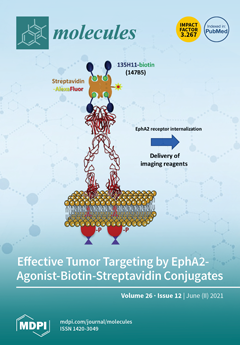Neurodegenerative disorders, including Tauopathies that involve tau protein, base their pathological mechanism on forming proteinaceous aggregates, which has a deleterious effect on cells triggering an inflammatory response. Moreover, tau inhibitors can exert their mechanism of action through noncovalent and covalent interactions. Thus, Michael’s
[...] Read more.
Neurodegenerative disorders, including Tauopathies that involve tau protein, base their pathological mechanism on forming proteinaceous aggregates, which has a deleterious effect on cells triggering an inflammatory response. Moreover, tau inhibitors can exert their mechanism of action through noncovalent and covalent interactions. Thus, Michael’s addition appears as a feasible type of interaction involving an α, β unsaturated carbonyl moiety to avoid pathological confirmation and further cytotoxicity. Moreover, we isolated three compounds from Antarctic lichens
Cladonia cariosa and
Himantormia lugubris: protolichesterinic acid (
1), fumarprotocetraric acid (
2), and lichesterinic acid (
3). The maleimide cysteine labeling assay showed that compounds
1,
2, and
3 inhibit at 50 µM, but compounds
2 and
3 are statistically significant. Based on its inhibition capacity, we decided to test compound
2 further. Thus, our results suggest that compound
2 remodel soluble oligomers and diminish β sheet content, as demonstrated through ThT experiments. Hence, we added externally treated oligomers with compound
2 to demonstrate that they are harmless in cell culture. First, the morphology of cells in the presence of aggregates does not suffer evident changes compared to the control. Additionally, the externally added aggregates do not provoke a substantial LDH release compared to the control, indicating that treated oligomers do not provoke membrane damage in cell culture compared with aggregates alone. Thus, in the present work, we demonstrated that Michael’s acceptors found in lichens could serve as a scaffold to explore different mechanisms of action to turn tau aggregates into harmless species.
Full article






